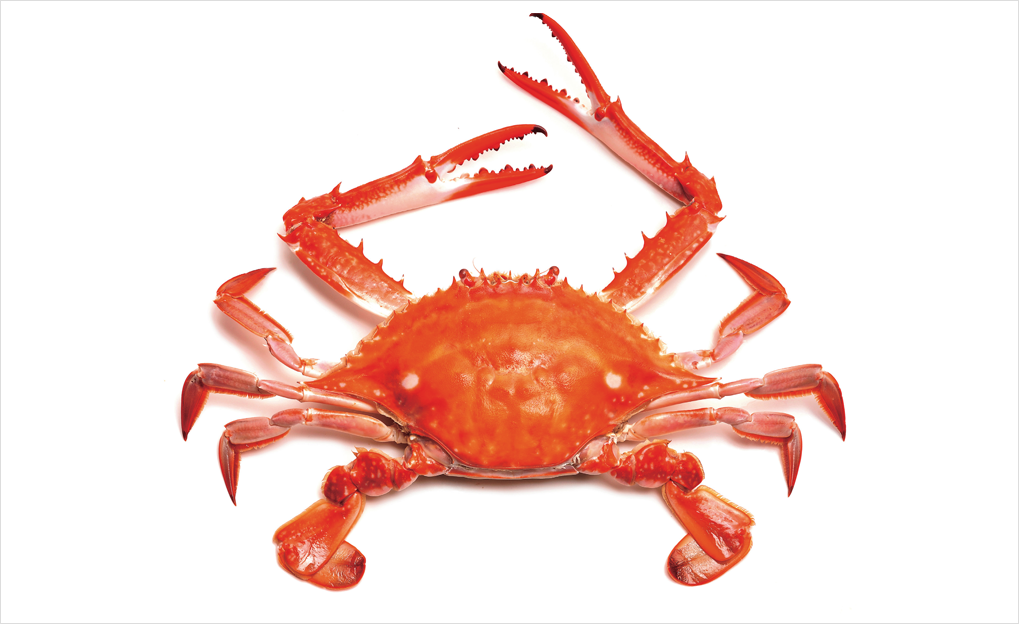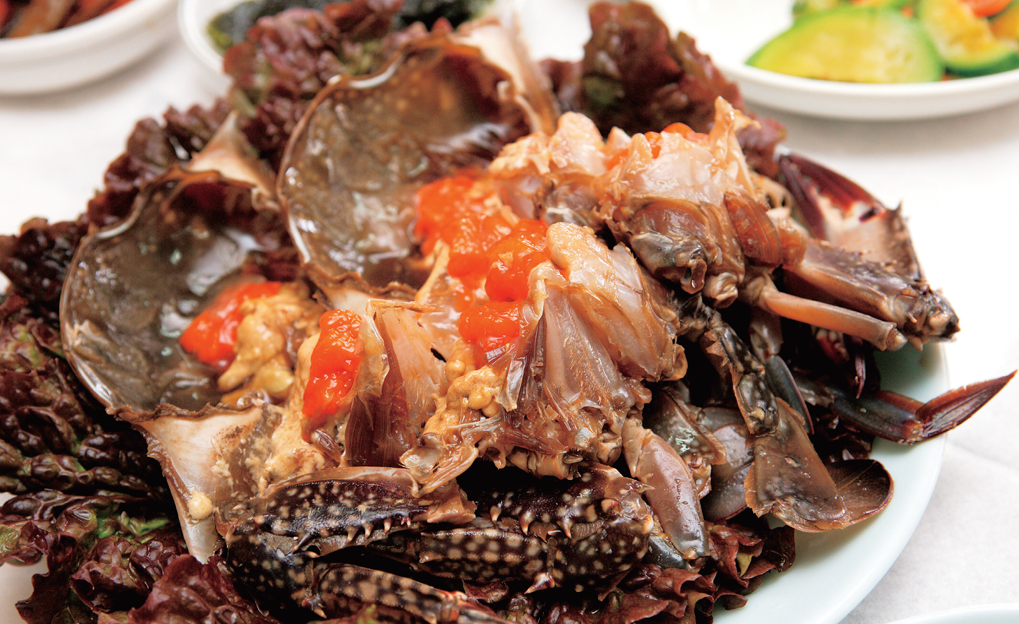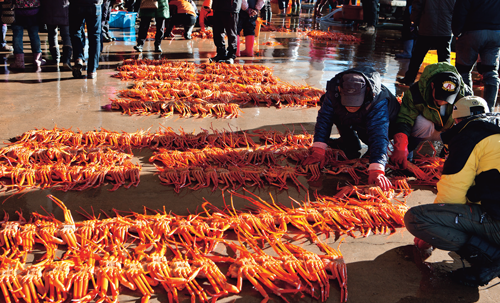The unique flavor of the blue crab, popular in Korea especially in spring and autumn, can be fully enjoyed without any special cooking process. The reason why its meat is so sweet and tasty is closely related to its method of survival.

Autumn is the season for blue crabs. Just thinking of the crabs full of meat makes the mouth water. Autumn is a season especially for the male crab because, after shedding its shell, it hardens its body in preparation for mating.
The blue crab’s shell turns red when heated, but that’s not why it is called kkotge in Korean although kkot may seem to mean “flower.” In this case, kkot refers to its two skewer-shaped horns (“skewer” is kkochaeng-i in Korean). This explanation is given in “Topical Discourses of Jibong” (Jibong yuseol), an encyclopedia compiled by Yi Su-gwang (1563-1628), a Silhak (Practical Learning) scholar in the mid-Joseon Dynasty. It contains a description of the crab’s swimming prowess: “The hind legs are flat and thin, resembling paddles, and are used for swimming.”
Two hundred years later, in “Register of Heuksan Fish” (Jasan eobo), a detailed study on the fish around Heuksan Island, off the southwest coast, Jeong Yak-jeon (1758-1816) wrote, “Most crabs can crawl about well but are not good at swimming, but this crab can swim well with its fan-like legs.” Hence the blue crab is also called the “swimmer crab” in English. Regardless of East or West, it seems people were impressed by the blue crab’s swimming ability.
The way a crab swims might look a bit strange, but everyone would agree with Jeong Yak-jeon’s description of the taste as “sweet.” Fresh autumn crab meat does in fact taste sweet. But the sweetness is very different from that of sugar. It is a delicate and complex flavor produced in salty sea water that is characteristic not only of the blue crab but also the snow crab (daege) of the East Sea, which has legs resembling bamboo, as well as the Russian king crab.
Secret of the Sweetness
The sweetness of crab meat derives from the abundant glycine, an amino acid, which accounts for 70 percent of the sweetness in sugar. Of course, the sweetness of crab is also influenced by sea water. To survive in salty sea water, the crab needs a certain substance to balance the salt concentration.
If the concentration of that substance is lower than that of sea water, the crab’s body fluids could leak into the sea due to osmotic pressure. Yet, salt cannot be used to balance the fluids. An excess of electrolytes from salt hinders the activity of the bodily enzymes, which can block activities necessary for life.
In sea fish, trimethylamine oxide (TMAO) balances salt concentration. TMAO usually has no smell or color, but is the cause of the fishy smell when it dissolves during the distribution and storage of fish. This substance is also found in crabs, which smell fishy when stored incorrectly. But in crabs and other crustaceans, it is glycine rather than TMAO that does the job of balancing salt concentration. The crab meat served at a seafood buffet restaurant tastes less sweet because the glycine disappears during steaming and processing. There’s more, however, when it comes to the crab’s sweetness. Beside glycine, crab meat contains alanine, another amino acid causing sweetness, as well as glutamine acid and nucleic acid which are responsible for the savory flavor of foods. In addition, various volatile substances contribute to the delicate and intensive flavor of crab meat.
The saltier the sea water, the more concentrated the free amino acids such as glycine and alanine, and the tastier the crab meat. Much as white radish and Chinese cabbage grown in the highlands are sweeter to prevent them from freezing, as autumn deepens and the sea becomes colder the amount of amino acids in crab meat increases. Thus, no complicated process is necessary for cooking crabs caught in autumn. Simply steaming them is enough to draw out the full flavor.
This is due to the Maillard reaction. Sugar and amino acids heated together turn brown, producing a complex flavor different from that of the original food ingredients, a process that usually occurs at high temperatures over 120 degrees Celsius. It is the same logic behind the fact that boiled meat does not have the aroma unique to a grilled steak. Crab meat is an exception, however, for its abundant amino acids and sugar content mean that it has a savory, nutty aroma even when steamed or boiled below 120 degrees. When crabs are cooked in the shell, the aroma is trapped and this intensifies the flavor.

Crab marinated in soy sauce, called ganjang gejang, is a favorite side dish of Koreans. It is made by pouring soy sauce boiled with garlic, onions and ginger over uncooked crabs and leaving them to ripen. Female crabs caught during March and April are normally used.
Self-Digestion Enzyme
Crabs can easily go bad during storage. When crabs die during transportation, their meat gets mushy and inedible. That is because the self-digestion enzyme contained in the hepatopancreas, the digestive organ of crustaceans such as crabs, is released when they die and dissolves the meat. Even the meat of crabs that are still alive when brought home can become mushy if not cooked immediately. The self-digestion enzyme is also activated when crabs are cooked at low temperature or undercooked. But if frozen immediately after being caught, meaty blue crabs can be enjoyed throughout the year.
Conversely, the traditional Korean dish ganjang gejang (crabs marinated and preserved in soy sauce) makes use of this self-digestion function. Soy sauce is boiled with garlic, onions and ginger, then cooled down and poured over well-cleaned raw crabs until they are fully covered and left to mature. The self-digestion enzyme and any microorganisms stuck to the crab dissolve the meat and internal organs, and in this process, the amount of free amino acids increases, enhancing the flavor.
This dish is a delicacy resulting from the combination of savory substances in the soy sauce and in the mushy crab meat. Very different from cooked crab meat, ganjang gejang tastes so good that it’s affectionately called the “rice thief,” meaning that it whets the appetite and makes a bowl of rice quickly disappear. There is even a record from the Joseon period that says live crabs were fed beef or chicken before being marinated in soy sauce to enrich the flavor. This recalls the French way of fattening geese to make foie gras.
As for crab eggs, they are not actually eggs. To be precise, they are ovaries yet to be fertilized. Crabs with such eggs can be eaten. But those with a lump of dark brown eggs revealed outside the body should neither be caught nor consumed.
Blue crabs mate in early autumn, but fertilization of the eggs does not occur during this time. The sperm is kept inside the female crab’s seminal vesicles and the eggs are fertilized in the following spring. The fertilized eggs look like flying fish roe hanging on a transparent thread. The eggs that poke out of the body are first orange-colored but turn dark brown over time. Crabs with fertilized eggs, whether blue crabs or snow crabs or king crabs, do not have much flavor. Female crabs, after using up their energy for reproduction, are not filled with meat, making them a less attractive catch, and they should not be caught for environmental reasons as well.
Usually, a female crab lays about 750,000 to 3,000,000 eggs, but on average, only one survives. Therefore, it is important to observe the permitted fishing seasons. For the same reason, research is annually conducted in America to estimate the number of blue crabs along its coasts.
Those who know how to enjoy the beauty of nature and the flavor of food also know when to let go and when to wait.
Like Autumn Foliage

At the seafood market, merchants arrange freshly-caught snow crabs. Thinshelled and full of meat, snow crabs with the cleanest taste are caught mostly in the East Sea. In the winter and following spring, the crabbing season, restaurants in the region are crowded with people out to enjoy fresh snow crabs.
The blue crab resembles autumn foliage. The yellow, orange and red colors of autumn leaves remain hidden by the green chlorophyll until it is destroyed by cold weather. Similarly, the blue shell of the live blue crab turns bright red when cooked as protein dissolves the color substance.
In the fields and mountains of Korea, the leaves start to change color in early autumn. But only part of the plants and trees change color. We have to wait a bit longer for the peak autumn foliage season when the mountains and fields are covered in red. The same applies to blue crabs. Every year in August, the off season ends and blue crab fishing starts again. But around this time, a lot of crabs are empty inside. Crabs, lobsters and other crustaceans cannot grow larger than their shell, so they have to shed their shells, or molt, periodically to grow. The biological cost of moving out of the old home and building a new one is high.
In the process, a large amount of muscle and energy is used up, leaving the crab half flesh and half water. It takes time to fill the watery part with flesh and harden the shell.
Soft crabs are crabs caught and eaten some time after molting. But, like the crabs carrying fertilized eggs, it is wise not to catch soft crabs. As autumn deepens and the foliage grows more resplendent, the flavor of the blue crab intensifies. Those who know how to enjoy the beauty of nature and the flavor of food also know when to let go and when to wait.